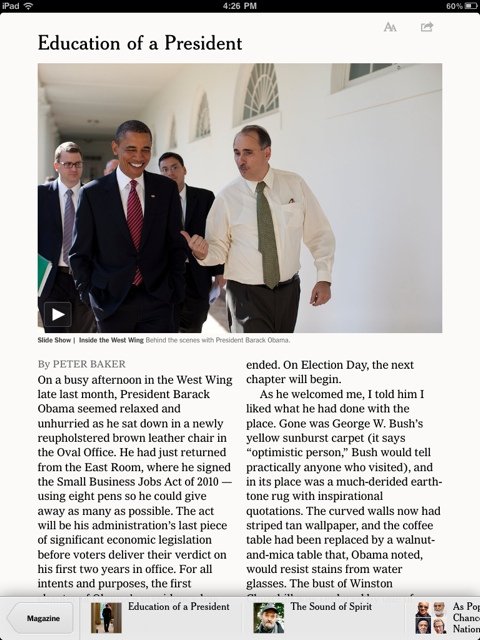
Tag: iPad
Untitled
Hungary’s constitution is being drafted on an iPad. “It’s a consumption device” trolls: it’s time to consume your hats.
The State of the Slate: Today’s iPad and Tomorrow’s Tablets
The iPad created a new class of computing devices and a new way of interacting with technology. It seems like this ambitious device means something different to just about every segment of the technology world: Old Media publishers herald the device as their salvation from death at the hands of the Web. Open software advocates balk at its controlled app platform as a regression for things like rich web applications and open standards. Tech pundits label it a device which prioritizes passive consumption of content over production and collaboration. Customers complain about the $500 starting price — and then buy over 15 million of them in under a year. (This quarter, Apple is on track to sell more iPads than Macs.)
I took the plunge and bought an iPad last September to see what all the fuss was about. I have to say that I don’t think any of the popular perspectives effectively mirror my experience. Things are about to change very quickly in this new space, and I think this is the appropriate time at which to reflect on its current state and potential in the future.
Aweditorium: Great Music Discovery for iPad
Devs keep on cranking out top-notch apps for the iPad that simply wouldn’t happen on another platform. This time up, we’ve got Aweditorium, an app that takes great music and supplements it with good (yet minimalistic) visuals to make for a great music discovery experience. Aweditorium supplies music, biographical information and photos on new artists, all streamed from their servers. The app has the ability to share a full stream of a song on Facebook or Twitter, and also encourages users to buy songs they like most straight from the iTunes store. (It should be noted that most indie artists get 70% of all revenue from the iTunes store.)
Aweditorium tickles me in all the right places:
- An excellent example of iOS apps’ capability to let technology help us experience art in new ways
- A fun and easy way to find and share great music
- Yet another channel for independent artists to get serious exposure without an evil music label
Yeah, my Apple Fanboy quotient is off the charts today. Blame Aweditorium, they’ve made a first-rate app.
[youtube=http://www.youtube.com/watch?v=23IVGdVnZ68&w=640&h=385]
New York Times for iPad: Legitimate heir to the Newspaper?

The Internet has shaken up the status quo for many incumbent economic leaders – and newspapers have seen this effect more so than any other industry. Since the Web hit the American household in the 1990s, print media has been experimenting with strategies for digital distribution and revenue streams, with few conclusive results after well over a decade. The Web has moved the audience’s attention from monolithic news outlets controlled by publishers in favor of social links (Facebook and Twitter) and aggregators (The Huffington Post, The Daily Beast and Drudge Report.)
This year’s announcement of the iPad seemed to change the publishing industry’s outlook on doing business over the Web. Instead of the hyperlinked, non-linear, short-attention-span, copy/paste-friendly nature of a desktop Web browser, the iPad offers a publishing platform similar to their paper product – with an iPad app, the publisher has verticalized control of available content, its layout, navigation experience, and – most importantly – revenue generation methods.
On October 15, the Times released “NYTimes for iPad,” (iTunes Link) labeling it “free until early 2011.” In testing it, I’ve decided it’s an excellent application in its own right, and could potentially be a great sign for the future of print journalism, but it could be yet another business fumble if the company doesn’t execute the proper balance between advertising, consumer pricing and usability.


